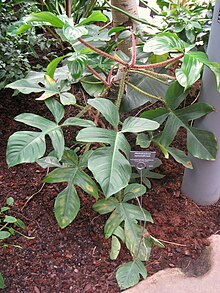| Philodendron squamiferum | |
|---|---|

| |
| Scientific classification | |
| Kingdom: | Plantae |
| Clade: | Tracheophytes |
| Clade: | Angiosperms |
| Clade: | Monocots |
| Order: | Alismatales |
| Family: | Araceae |
| Genus: | Philodendron |
| Species: | P. squamiferum |
| Binomial name | |
| Philodendron squamiferum Poepp. & Engl. | |
Philodendron squamiferum, known as Squamiferum for short, is a rare species of plant in the family Araceae, native to French Guiana, Suriname, and northern Brazil. This climbing plant has leaves with five lobes and has a climbing growth habit. It is well-known among Philodendron species for its distinctive reddish stalks, which are covered in small bristles that give it a hairy appearance.
Description
Philodendron squamiferum is a rare houseplant with unique five-lobed (five-partite) dark green leaves and a scaly reddish petiole.
Toxicity
Philodendron squamiferum is toxic because of the presence of calcium oxalate crystals. Oxalate crystals can cause pain and swelling upon contact with the skin or mouth, and pain, swelling, hoarsenes and difficulty swallowing if ingested.
References
- Kew World Checklist of Selected Plant Families
- Marc Gibernau and Denis Barabé, "Pollination ecology of Philodendron squamiferum (Araceae)", Can. J. Bot. 80: 316–320 (2002)
- Bown, Deni (2000). Aroids: Plants of the Arum Family. Timber Press. pp. 217–218. ISBN 978-0-88192-485-5.
- Quattrocchi, Umberto (2012). CRC world dictionary of medicinal and poisonous plants: common names, scientific names, eponyms, synonyms, and etymology. Boca Raton: CRC press. p. 2879. ISBN 9781420080445.
- "Plants That Irritate". Children's Hospital of Philadelphia. 5 May 2014. Retrieved 26 October 2023.
| Taxon identifiers | |
|---|---|
| Philodendron squamiferum |
|